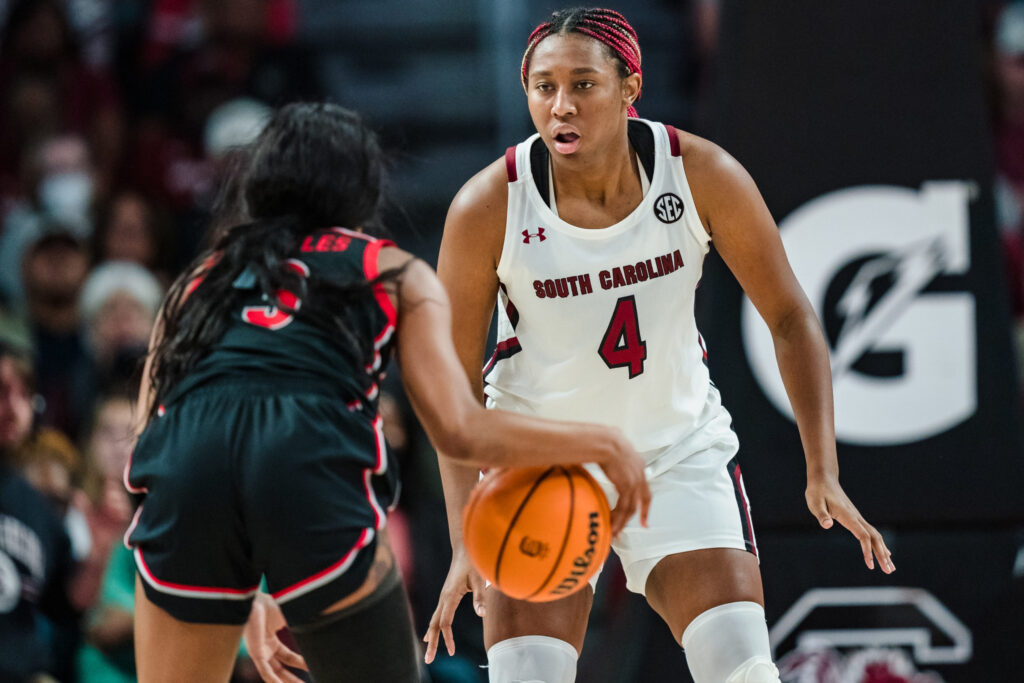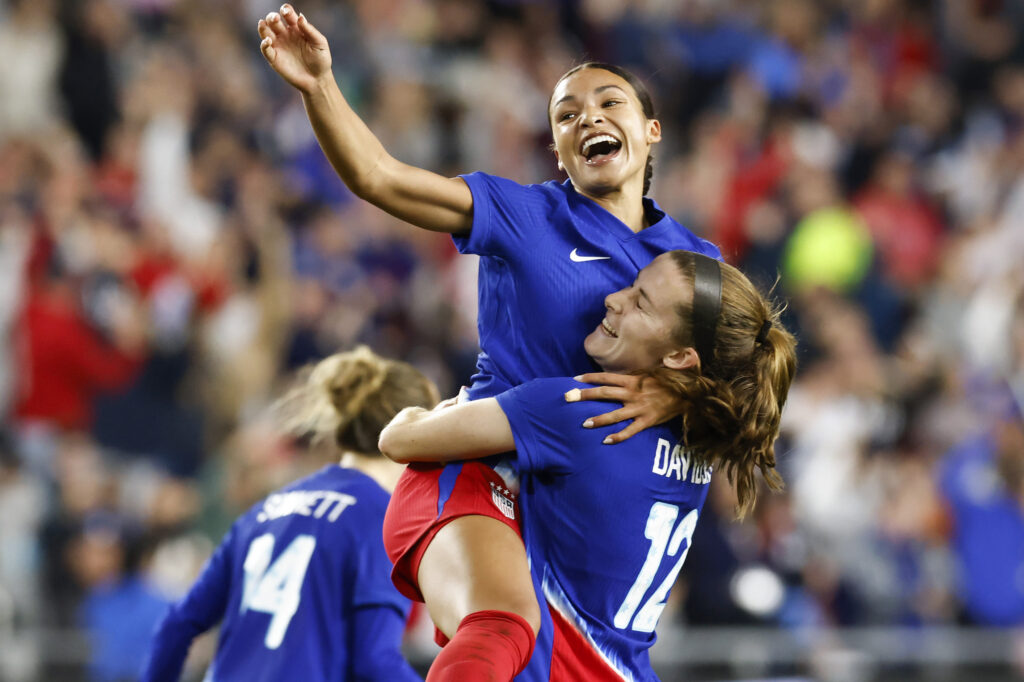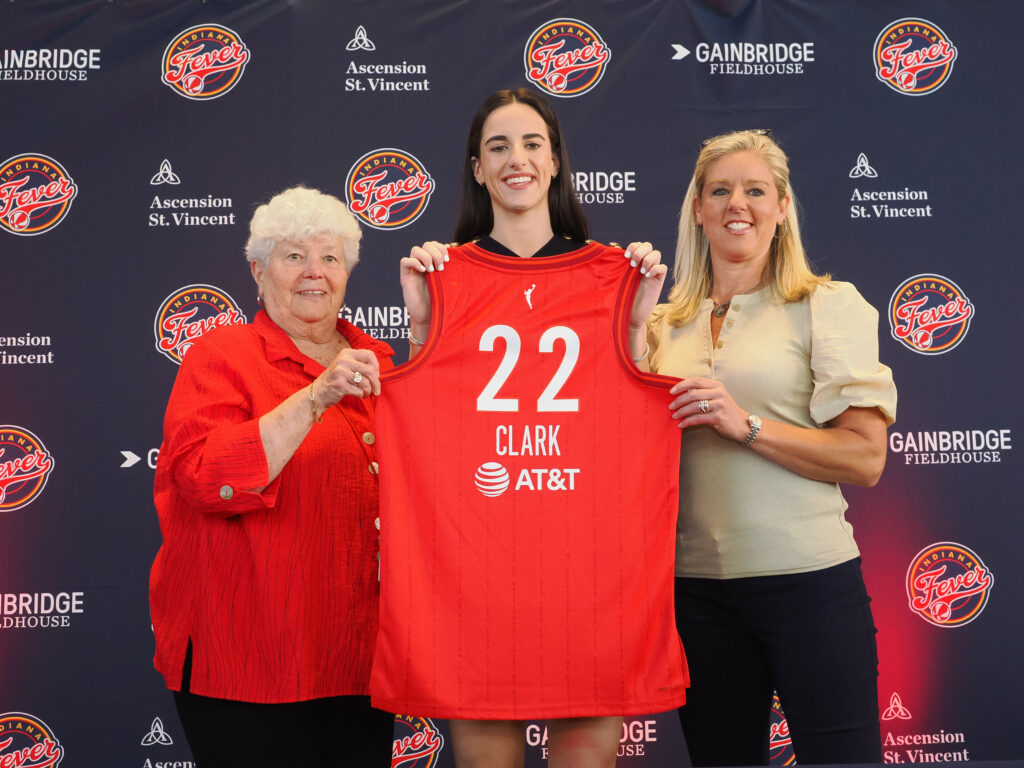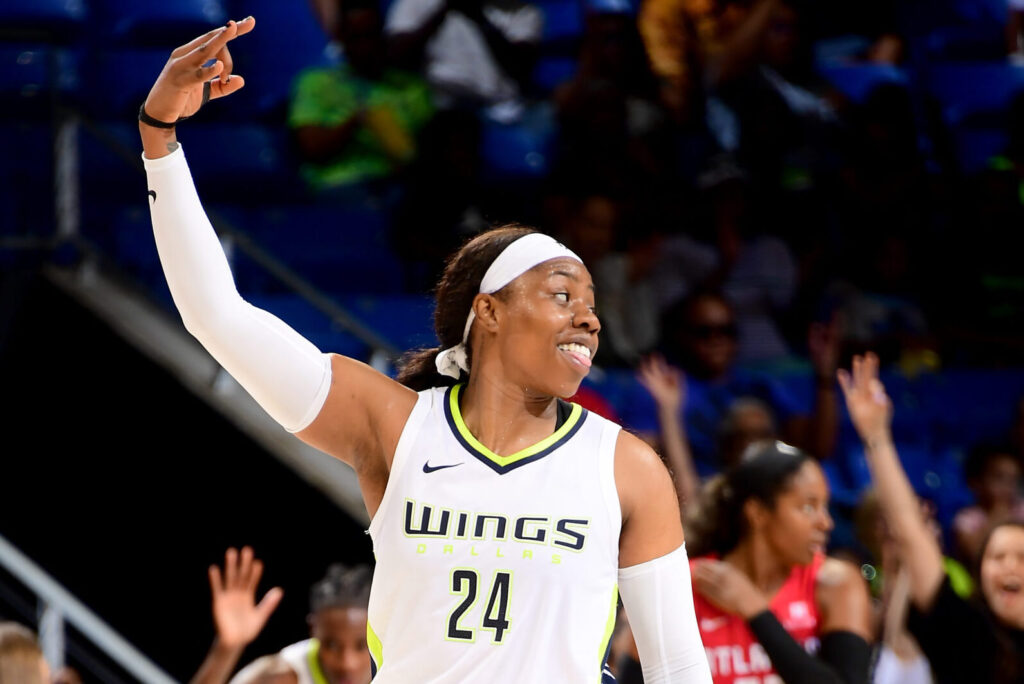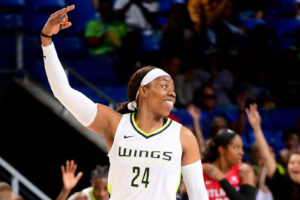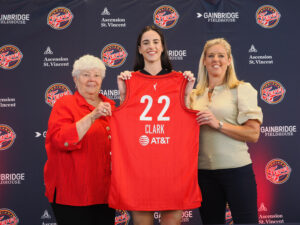We are back with our second annual WNBA Top 50 Big Board. Here, you can find the top players WNBA general managers, scouts and coaches are keeping an eye on as they prepare for the 2023 draft in April.
It is still largely unknown whether these prospects will declare for the draft, use a fifth-year of eligibility or secure an NCAA waiver to return after suffering an injury. But as things stand now, here is the Just Women’s Sports WNBA Big Board.
NOTE: These players do not appear in any specific order.
Aliyah Boston, C, South Carolina
Boston is arguably the most dominant player in the country with her unique combination of size, finishing ability, defense and rebounding prowess. Boston makes the game look easy. She is patient, processes action exceptionally well and is an elite passer out of the post. Her efficiency around the rim requires opponents to game plan for her specifically. Boston demands double and triple teams, and despite what she goes up against every game, she has remained a consistent force and a walking double-double throughout her career. It will be worth watching how her game translates to the next level when opposing defenses aren’t zeroed in on stopping her.
Diamond Miller, G, Maryland
Miller might have the most potential and versatility of anyone in this draft class. As a 6-3 guard, she has the length, frame, skill and shot-creating ability to excel at the next level. Miller is putting up career numbers in her fourth year with the Terrapins, averaging 19.9 points, 6.4 rebounds, 2.8 assists and 1.3 blocks while shooting 47.5 percent from the field. The senior is impacting games for Maryland on both sides of the ball with her ability to accelerate in the open floor, her lateral quickness and her wingspan. One of the more underrated aspects of Miller’s game is her ability to facilitate. It’s hard to fathom Miller landing anywhere outside of the lottery in the upcoming draft.
DIAMOND MILLER WITH THE BUZZER BEATER 🚨
— SportsCenter (@SportsCenter) December 2, 2022
No. 20 Maryland takes down No. 7 Notre Dame in a late thriller 😱 @TerpsWBB pic.twitter.com/nxkrN7NDsL
Haley Jones, G, Stanford
Jones is an all-round player with a phenomenal basketball IQ and passing vision. She can guard any position on the floor and has the versatility to play the coveted point forward. Her size and skill can pose all sorts of mismatch problems for opponents. Jones can score at the rim efficiently and knock down mid-range shots (though her mid-range shooting percentage is down this season). Jones’ inconsistent perimeter shooting is a concern: The senior has made just three 3-pointers for Stanford this season. Her draft position will depend on how teams envision her skill set translating to their system and whether they believe that her offensive perimeter game can expand.
Rickea Jackson, G/F, Tennessee
Jackson has draft lottery potential with the way she can impact a game at every level. She drives aggressively to the basket, making it difficult for defenders to keep her in front of them. She is also a nightmare in the paint, where she can hit shots from mid-range. At 6-foot-2, Jackson has the elite length and skill set for a pro team to leverage in a variety of ways. Where she lands in the WNBA draft could hinge on her performance with Tennessee down the stretch of the season.
RICKEA JACKSON IS THAT GIRL
— Lady Vols Basketball (@LadyVol_Hoops) January 22, 2023
📺 SEC Network +
📲 https://t.co/dIz0RW8DqA#GoLadyVols pic.twitter.com/l2fpLbKFLf
Elizabeth Kitley, C, Virginia Tech
Kitley has the length and skill to go along with an elite ability to play with her back to the basket and face up. The back-to-back ACC Player of the Year is currently leading the Hokies with 18.8 points and 10.7 rebounds per game. She is a serviceable defender who provides rim protection as a shot blocker and uses her basketball IQ to make good decisions. She would add unique depth to any WNBA frontcourt and team that’s willing to develop her for the future.
Jordan Horston, G, Tennessee
At 6-2, Horston has the length and athleticism to impact games as a scoring threat and an elite defender. She is efficient off the dribble and explosive off the bounce, covering a lot of ground with her first step. She can score from deep, expose mismatches on the block and hit mid-range jumpers that are difficult to defend. This season, Horston has shown resilience and an ability to elevate her play in key moments while putting up the most efficient numbers of her college career. Horston certainly has first-round potential if she chooses not to use her extra year of eligibility.
Stephanie Soares, C, Iowa State
The two-time NAIA Player of the Year made an immediate impact at Iowa State, catching the eye of WNBA teams before suffering an ACL tear 13 games into the season. Regardless of whether she requests a waiver for an additional year of eligibility, Soares has made her case for the WNBA. At 6-6, she can shoot the 3, handle the ball and block shots. She has an extremely rare combination of athleticism, size and skill. Every single WNBA team is taking a good look at Soares this season and evaluating her potential. She’ll need to get stronger to compete in the pros, especially on the block, but anyone who watches her can see how high her ceiling is. Soares had draft lottery potential before the injury, and even after it, a team could select her in the first round as an asset for the future.
Another double-double for Stephanie Soares, her seventh of the season, 10 points and 12 rebounds so far!
— Cyclone Basketball (@CycloneWBB) December 31, 2022
Q3, 3:48 | 54-41 ISU
🌪🏀🌪 pic.twitter.com/kALwZgIVDI
Maddy Siegrist, F, Villanova
Siegrist currently leads the nation in scoring at 29.0 points per game. The senior became Villanova’s all-time leading scorer against Creighton in late January and now has over 2,700 points. The 6-1 forward is also putting up her most efficient numbers this season, shooting 51.6 percent from the field and 38.4 percent from 3. She has an intriguing skill set and impressive scoring ability, but there are concerns about how her game will translate to the WNBA. At the next level, she’ll be tested on defense and on offense against more complex defensive schemes.
Zia Cooke, G, South Carolina
Cooke is playing some of the best basketball of her career as a senior. Leading the Gamecocks in scoring at 15.5 points per game, the 5-9 guard is effective when shooting from mid-range and getting to the rim. Cooke has lacked consistency from the 3-point line at times during her career, but she is shooting 37 percent from the perimeter this season. She has proven that she can create her own shot and score in bunches. Cooke’s 2023 draft stock can climb if she remains consistent, efficient with her shot selections and continues to make good decisions.
Charisma Osborne, G, UCLA
Osborne has the attention of the WNBA as a dynamic guard able to impact games as both a high-level scorer and an elite defender. Osborne has been UCLA’s primary offensive, three-level scoring weapon for most of her career. With excellent burst and lateral speed, she creates her own shot, adjusts well depending on what defenses throw at her and makes good reads. Osborne’s on-ball defense is as strong as any other player’s in the country. At just 5-8, however, she’ll need to find the right situation to succeed at the next level.
Ris in the mid-range, that's a bucket.
— UCLA W. Basketball (@UCLAWBB) March 1, 2023
📺: Pac-12 Network
📲: https://t.co/f5YVZnJId9#GoBruins | @CharismaOsborne pic.twitter.com/plty9OvWj3
Laeticia Amihere, F, South Carolina
Amihere is flying under the radar in WNBA draft conversations. How often do you find a 6-4 forward with length, athleticism and an ability to play nearly any position on the floor? With a loaded South Carolina team, Amihere makes the most of her 16 minutes per game, averaging 6.5 points, 3.3 rebounds, 1.3 assists and 1.1 blocks per game. Her inside-out game on both offense and defense would allow WNBA teams to go with a bigger, longer lineup — which she has become accustomed to in Dawn Staley’s system. Amihere provides rim protection, rebounds the ball and makes big plays when needed. WNBA teams should have her on their short list heading into the draft.
Taylor Mikesell, G, Ohio State
The fifth-year sharpshooter has the ability to get hot and shift momentum in her team’s favor, knocking down multiple 3s a game. WNBA teams have their eye on players who are efficient shooters and have the ability to stretch the defense with potent perimeter play. Mikesell, a career 41 percent 3-point shooter, is one of the best in the country in that category. The 5-11 guard is not just a one-dimensional scorer, which is a bonus at the next level. She’s athletic with a pro-ready build and great court vision, averaging 2.6 assists per game this season. Mikesell is set up to have a highly successful WNBA career.
Ashley Joens, G, Iowa State
Joens is a highly efficient and experienced guard, capable of exposing mismatches with her size down low. She leads Iowa State in scoring with 20.5 points per game on 34.7 percent shooting from the 3-point line. In addition to her skill set, she has displayed an exemplary work ethic during her five years in Ames. Joens’ draft stock hinges on how teams think her game will translate to the pros, especially when the offense no longer runs through her.
Celeste Taylor, G, Duke
Much of Duke’s success this season is a credit to Taylor, who is putting up the best numbers of her four-year career while earning a reputation as one of the top defenders in the ACC. Taylor leads Duke in scoring (11.8 points per game) and steals (2.0), and she is shooting a career best 40.8 percent from the field. She can score in a variety of ways, most notably from mid-range. The 5-11 guard has improved her perimeter efficiency every season, shooting over 33 percent the past two seasons. Taylor’s elite on-ball and gap defense is a result of her length, explosiveness and instincts. She also rebounds the ball well from the guard spot.
CELESTE TAYLOR CHASEDOWN BLOCK
— Duke Women’s Basketball (@DukeWBB) February 24, 2023
😤😤😤 pic.twitter.com/Tx1Y9fHCdn
Alexis Morris, G, LSU
The fifth-year guard made stops at Baylor, Rutgers and Texas A&M before spending the last two years at LSU. Morris has been exceptional for the Tigers as a dynamic guard with a big-time motor who can defend, score and facilitate. The 5-6 point guard is putting up some of the best and most consistent numbers of her career, including from 3-point range, where she is shooting 35.2 percent. Her stock has been on the rise this season and has turned many heads in the WNBA, especially after her 23-point performance against No. 1 South Carolina on Feb. 12. If Morris maintains this level of production, she has a shot to propel herself into the first round of the draft.
Leigha Brown, G, Michigan
Leighia Brown has a versatile skill set and impressive intangibles. She can score, create, rebound and defend. The 6-1 fifth-year can play as the lead guard for Michigan and can also expose mismatches on the block with her ability to play with her back to the basket. She is a three-level scorer, and while her three-point shooting percentage is down this season, she has consistently shot above 30 percent for her career. The area of Brown’s game that is most intriguing is her elite vision and passing ability for her size — she leads Michigan in assists with 5.9 per game this season. Whichever team selects Brown in the upcoming draft will be getting a complete package.
Taylor Robertson, G, Oklahoma
Robertson is a sharp-shooting specialist, averaging 44 percent from 3-point range during her five-year NCAA career. Robertson holds the Big 12 and Oklahoma career 3-point shooting records and is arguably the best shooter in the country. Robertson’s perimeter efficiency warrants a look from any team in the league. If she can make the jump defensively to the pros, she has a shot to make a roster.
Monika Czinano, C, Iowa
Czinano is No. 4 in the country in field-goal percentage, averaging 66.5 percent from the field this season. That mark is not surprising considering the fifth-year center has shot 66 percent for her entire career at Iowa. At 6-3, Czinano could be considered undersized for a traditional five in the WNBA. But her predecessor, Iowa alum Megan Gustafson, is an example of someone who has found ways to make an impact in the league the last four years. Iowa has a strong track record of developing WNBA-ready post players, and Czinano has the tools, low-block understanding and efficiency inside to warrant a look.
That Caitlin Clark ➡️ Monika Czinano connection 😤
— espnW (@espnW) January 24, 2023
📺: ESPN2 pic.twitter.com/sT4cS7Hy6H
Dyaisha Fair, G, Syracuse
Fair has an elite scoring mentality and ability to create her own shot despite her small stature at 5-5. She is especially successful in transition, getting downhill quickly and making it difficult for defenders to get in front of her. Fair has a smooth, steady jumper and can also shoot it from deep. The question is how WNBA teams see her lack of size and efficiency translating to the next level on both sides of the ball. Is she a true point guard and can she defend bigger guards? Can she create her own shot while not getting nearly as many attempts?
Grace Berger, G, Indiana
Berger has been one of the Hoosiers’ most consistent players her entire career. As a combo guard, Berger can play on or off the ball and is averaging the best assist numbers of her career this season at 4.8 per game, despite missing several months with a knee injury. Her offensive arsenal includes one of the best mid-range games in the country, with an ability to create off-ball screens and get off her own shot. One of Berger’s biggest strengths is her smart shot selection. She has a way to manufacture points in the paint, find her way to the rim and take over games. In the WNBA, Berger will likely play as a backup two guard who can initiate offense and provide steady defense. The biggest area of concern is her 3-point shooting, where she has averaged just 30 percent during her career.
Jessika Carter, C, Mississippi State
After redshirting last season, Carter has returned to lead Mississippi State in scoring (14.8 points per game) and blocks (2.1). At 6-5, Carter brings imposing size and one of the best wingspans in this draft class. She also has elite rim protection, rebounding abilities and mobility. Her draft stock depends on how she fares against top-level competition the rest of the season. She would have a learning curve in the WNBA, but she is an intriguing prospect for a team that could commit to developing her.
Hannah Jump, G Stanford
Jump could return to Stanford and use her extra year of eligibility, but regardless of when she enters the draft, there is a need for sharpshooting specialists in the WNBA. The 6-0 guard is ninth in the country with a 44 percent shooting percentage from the perimeter this season. She has great footwork when running off action and spotting up, a quick release, and deep range off the line. In her Stanford career, 79 percent of shots have come from the 3-point line. She is just the type of specialist WNBA teams could be looking for.
.@hannah_jump at the buzzer 🚨 @StanfordWBB
— espnW (@espnW) December 19, 2021
📺 ESPN2 pic.twitter.com/y1KvH4J4sy
Mackenzie Holmes, F, Indiana
A highly skilled forward with great hands and finishing ability, Holmes excels at thinking two steps ahead and exposing defenders in the paint. She plays well out of pick-and-roll situations and any five-out or four-out system. At 6-3, Holmes can face up a step off the lane line and sweep and rocker off the dribble. She’ll need to continue to stretch the floor as a perimeter threat. Holmes has indicated her intention to return to Indiana next season for her fifth year, but she is worth noting regardless as one of the top players in the country.
Jacy Sheldon, G, Ohio State
Sheldon has appeared in just six games for the Buckeyes this season while recovering from a lower leg injury, but her production — over 14 points per game in each of the past three seasons — warrants consideration. The 5-10 wing has a great feel for the game as an offensive slasher and scorer. She has the passing prowess to be efficient in the half-court, with the ability to cut off the ball and be aware of floor spacing. She also can attack the rim and finish in traffic.
Lou Lopez Sénéchal, G/F, UConn
After tearing up the MAAC for three years, Lopez Sénéchal took her talents to UConn, where her production hasn’t skipped a beat. The 6-1 guard/forward is one of the best scorers in the country, and she’s gotten even more efficient at the next level. Last season with Fairfield, she was shooting 43 percent on nearly 17 shots per game for a scoring average of 19.5. With UConn this year, Senechal is taking 12.6 shots per game, boasting a higher efficiency at 46.2 percent from the field and 43.2 percent from deep, and averaging 16.7 points per game. She continues to get better and is now producing on a stage that can prepare her for the pros.
LOU LOPEZ SÉNÉCHAL AT THE BUZZER 🤯
— Just Women’s Sports (@justwsports) February 5, 2023
UConn leads South Carolina 25-14 after one. pic.twitter.com/xqwGmp39Jy
Kayana Traylor, G, Virginia Tech
Traylor is an experienced and versatile guard capable of playing multiple positions on and off the ball. She has a strong motor and explosiveness and can finish through contact at the rim. She is also a capable perimeter threat who demands respect from defenses. A solid defender who’s able to adjust to different schemes, Traylor also has the basketball IQ to contribute as a passer on the other end. She has been a steady player for the Hokies the last two years.
Ashley Owusu, G, Virginia Tech
Owusu started seven games for Virginia Tech before breaking her pinkie in early December. Since she returned in late January, the Maryland transfer has averaged just nine minutes per game. Owusu is an elite facilitator who makes great decisions in the two-man game and is constantly surveying the court for the correct read. When she’s not creating, she is a prolific scorer, capable of putting up big numbers in a variety of ways. If the 6-0 guard continues to struggle to crack the Hokies’ lineup into March, her draft stock could take a hit. While Owusu is draft eligible this season, she could opt to use her fifth year of college eligibility.
Madi Williams, F, Oklahoma
Williams has plenty of intangibles to go along with her five-years of experience as a big guard. She’s been a prolific scorer during her time at Oklahoma, but she is only a 30 percent career 3-point shooter. Williams can handle the ball, can push it in the open floor and has great open court vision. Her stock is dependent on her perimeter shooting and how teams think her game can translate to the wing full-time. Williams has second- or third-round potential.
Abby Meyers, G, Maryland
The reigning Ivy League Player of the Year transferred from Princeton to Maryland this season and made an immediate impact in the competitive Big Ten. The 6-0 guard is averaging 37.9 percent from the 3-point line, just under her career high, and a career-best 2.6 assists per game. Meyers is a natural-born leader who brings poise and composure to the court. She’s not going to turn the ball over much and could be used as a deep shooting threat in the pros. A WNBA team could target her as a late-round, backup option in the draft.
Abby Meyers was unreal tonight 🤯
— Maryland Women’s Basketball (@TerpsWBB) February 25, 2023
🏀 24 PTS (10 in Q4)
🏀 11-15 FG
🏀 6 REBS
🏀 3 STLS#FTT x #LegUSy 🐢 pic.twitter.com/aAKZI3KhB4
Honesty Scott-Grayson, G, Auburn
Scott-Grayson has been a key contributor for Auburn the past three years, but she’s elevated her play to another level this season. Her numbers are up across the board, with the senior shooting 40.8 percent from the field and 38.1 percent from the perimeter. The 5-9 guard has a special ability to make tough, contested shots in the mid-range. As she continues to develop her perimeter shooting, she stands out as a three-level scorer with elite athleticism and defensive abilities.
Taiyanna Jackson, C, Kansas
Jackson is an underrated prospect in this draft. At 6-6, she’s having a breakout season for Kansas, coming into her own just in time for the draft. Jackson is averaging a double-double of 15.4 points and 12.6 rebound per game to go along with three blocks per game. She is also shooting a staggering 68.1 percent from the field. Jackson has a pro-ready build with high-level potential for a team willing to develop her.
Aijha Blackwell, G/F, Baylor
Blackwell has played in just eight games for Baylor after suffering a knee injury early in the season. There’s a good chance she returns to the Bears next season, but she is technically draft eligible this year. At 5-11, Blackwell is appealing to WNBA teams because she possesses a combination of versatility and power that is hard to find. She can play within any system and the speed of the game comes naturally to her. She is skilled on the perimeter, and she can expose a mismatch with her back to the basket to go along with her elite rebounding from the guard spot.
Elena Tsineke, G, South Florida
Tsineke is an undersized guard but a dynamic scorer who can create in the full court and out of the pick and roll. She can put up a lot of points and knows how to create space for herself at the rim. She is shooting a career-best 37 percent from 3 this season. Tsineke is one of the more underrated players in the country who has a chance to be a viable, late-round draft pick.
Keishana Washington, G, Drexel
The fifth-year superstar is averaging 27.1 points per game for Drexel, good for third in the nation, and has made it clear she knows how to stuff a stat sheet. Washington’s numbers have increased in nearly every statistical category this year. The 5-7 guard has not only evolved into one of the most versatile scorers in the country, she can also create, leading Drexel with four assists per game. For a team looking for a dynamic scorer who can provide backcourt depth, Washington certainly deserves a look.
.@DrexelWBB's Keishana Washington is averaging 30 PPG, 3.0 RPG, and 4.8 APG so far this season. 👀
— Just Women’s Sports (@justwsports) November 23, 2022
Most underrated player in the country? pic.twitter.com/yRybaRmMzO
Dorka Juhász, F, UConn
Juhász is as experienced as they come, competing at a high level internationally before playing a successful three years at Ohio State and the past two at UConn. What makes Juhász so valuable is her ability to understand her role based on the system. She has the IQ and selflessness to compliment key players. At the next level, she can contribute in a multitude of ways, from scoring within 17 feet, rebounding the ball and passing out of the frontcourt.
Brea Beal, G, South Carolina
Brea Beal is intriguing when you consider what she brings as a pure defensive specialist. She has been South Carolina’s longtime leader on defense, thriving in nearly every assignment where she is matched up with the best players in the country. Beal has a strong frame, great lateral speed and elite instincts on and off the ball. She’s an effective rebounder, does not make many mistakes and se takes care of the ball. Still, she’ll need to prove she can be an offensive weapon to make a legitimate impact in the pros.
Victaria Saxton, F, South Carolina
The fifth-year forward is experienced and has been developed as well as they come under coach Dawn Staley. Saxton stands out for her length, especially when she is attacking the offensive glass and creating second and third opportunities for her team. For a team looking for a late-round asset, Saxton is a good option. She’s not going to make a lot of mistakes and could seamlessly integrate into almost any system. She’s also proven to be a solid defender on one of the top defensive programs in the country.
Nice sequence for Victaria Saxton pic.twitter.com/Z2cv5JK38M
— Steve Jones Jr. (@stevejones20) February 20, 2022
Diamond Battles, G, Georgia
Battles has been on WNBA teams’ radars since her four-year career at UCF. The 5-8 guard has the full package as a facilitating and scoring guard, and her game has translated to her fifth year at Georgia. Her high motor makes her an undeniable asset on both ends of the floor. Battles leads Georgia with 14.4 points and 3.1 assists per game. While her shooting percentages are down this year, she’s a capable perimeter shooter who averaged 36 percent for UCF last season. Battles could serve a WNBA team well as a late-round pick.
Jakia Brown-Turner, G, NC State
The 6-0 wing has a wealth of experience at NC State, starting 120 of 121 games and notching over 3,460 minutes in her career. A three-way scoring threat, she is primarily left-hand dominant when getting it to the rim and uses her shot fakes effectively. She is also a strong rebounder from the guard spot. Brown-Turner has been a steady factor for the Wolfpack, even though she has not had her most efficient season, shooting just 35.9 percent from the field. Her draft stock could hinge on her consistency and ability to make tough shots in March.
Dulcy Fankam Mendjiadeu, F, USF
Mendjiadeu has been a walking double-double for South Florida this season, averaging 17 points and 12.6 rebounds per game. While she has limited range, she has elite efficiency, shooting 60.2 percent from the field this season. The effort she puts forth on the glass is desirable for any franchise looking to create second-chance opportunities. At 6-4, she has the length, strength and motor to hold her own as a proShe has a shot to go much earlier than most are considering. and has a chance to go much earlier than most are expecting her to.
Myah Selland, G/F, South Dakota State
The sixth-year guard has played more minutes than anyone else on this draft board, with over 3,860 and counting. The reigning Summit League Player of the Year impacts the game in nearly every way and is the only active Division I player in the country to score over 1,800 points, collect 750 rebounds and have over 400 assists. She also leads the Summit League in assist-to-turnover ratio. Between her experience, knowledge of the game and overall skill set, she deserves consideration as a late-round draft option.
Shaylee Gonzales, G, Texas
There were questions as to how Gonzales’ game would translate to Texas after a decorated career at BYU. The 5-10 guard has put up big numbers her entire career, and her 12.5 scoring average this season is notable considering she is getting close to five fewer shots per game with the Longhorns. Gonzales has a good handle on the ball and can serve as a great complement to a primary ball-handler in the backcourt. She can score at all three levels and has the body control and strength to finish at the rim in traffic.
That's how you start the game. 🤘 @shayleegonzales pic.twitter.com/YWlIpeKs4A
— Texas Women's Basketball (@TexasWBB) February 25, 2023
Erynn Barnum, F, Arkansas
The 6-2 redshirt senior is having a great season this year for the Razorbacks, averaging 15.8 points and 6.9 rebounds per game. She is used to an up-tempo system, is an excellent rebounder and finishes strong around the rim. A WNBA team will need to see the potential to expand her ball-handling and perimeter shooting for her to stick to a roster.
Rebeka Mikulášiková, C, Ohio State
Mikulášiková has come into her own this season for Ohio State. Her confidence is at an all-time high as she hones a European skill set with her unique size and powerful game. At 6-4, she can play with her back to the basket and is efficient around the rim, but what makes her so special is her ability to stretch the floor. WNBA teams are always looking for the combination of size and perimeter shooting, and Mikulášiková is averaging a career-best 34.5 percent from deep this season. She still has NCAA eligibility and has yet to decide what she will do after this year.
Sydney Taylor, G, UMass
Taylor has great instincts as a well-rounded guard. The 5-9 sharpshooter has been a prolific scorer the entirety of her career, with half of her shots coming from the perimeter. She has proven that she can get hot and knock down multiple 3s to shift the momentum in a game. She reads defenders well and can run off different actions to create her shot. Given the consistent need for versatile, perimeter shot-makers, Taylor deserves a look in this upcoming draft.
Quinesha Lockett, G, Toledo
Having scored over 1,800 points over four years at Toledo, Lockett has demanded the attention of defensive schemes the entirety of her career. At 5-10, she has a quick first step that allows her to attack her defender’s hip, slide by and finish at the rim. While she can shoot the 3, she’s averaged only 30 percent from the perimeter at Toledo. Lockett has been a consistent scorer, rebounder and defender during her career and is a key reason the Rockets were considered preseason favorites to win the MAC. Lockett deserves a good look as a late-round option.
Lauren Ebo, C, Notre Dame
Ebo has gained considerable experience as a fifth-year grad student for the Irish after playing four years with Texas. At 6-4, Ebo has imposing size and strength on the interior. Her numbers have steadily increased every season, with the center averaging 9.1 points and 6.6 rebounds per game while shooting 51 percent from the field. Ebo’s game could translate to the WNBA as a traditional, low-block presence who’s able to play out of the pick and roll.
KK Deans, G, Florida
Deans is undersized as a guard, but her strength and motor make Florida go. The way she plays the game makes her seem much bigger than her 5-8 frame. Deann has shown an ability to get hot from the perimeter, making 2.3 3-pointers per game for Florida this season. She sees the floor well and can create for her teammates. What makes Dean special is her no-quit mentality and ability to impose her will on opponents. She has definite late-round potential.
👌 from 👌@kkdeans with 14 points in the first half against Georgia#NCAAWBB x 🎥 @GatorsWBKpic.twitter.com/vNDMoPsOEZ
— NCAA March Madness (@MarchMadnessWBB) January 8, 2023
Kiki Jefferson, G, James Madison
The 6-1 guard leads James Madison with 18.3 points, 8.1 rebounds and 3.0 assists per game this season. She made the midseason watch list for the Becky Hammon Mid-Major Player of the Year for the second consecutive year. Jefferson has good body control in the lane, can see the court well and is both a versatile scorer and elite rebounder from the guard position.
Starr Jacobs, F, UT Arlington
Jacobs was also named to the Becky Hammon Mid-Major Player of the Year watch list as the Reigning Sun Belt Player of the Year and WAC Preseason Player of the Year. After a monster redshirt junior campaign, the 6-2 forward leads UT Arlington this season with 17.1 points and 8.4 rebounds per game on nearly 50 percent shooting from the field. While she’s not a perimeter threat, Jacobs has elite length, athleticism and leaping ability. She also passes the ball exceptionally well and has good control of her length in the paint.
Rachel Galligan is a basketball analyst at Just Women’s Sports. A former professional basketball player and collegiate coach, she also contributes to Winsidr. Follow Rachel on Twitter @RachGall.
